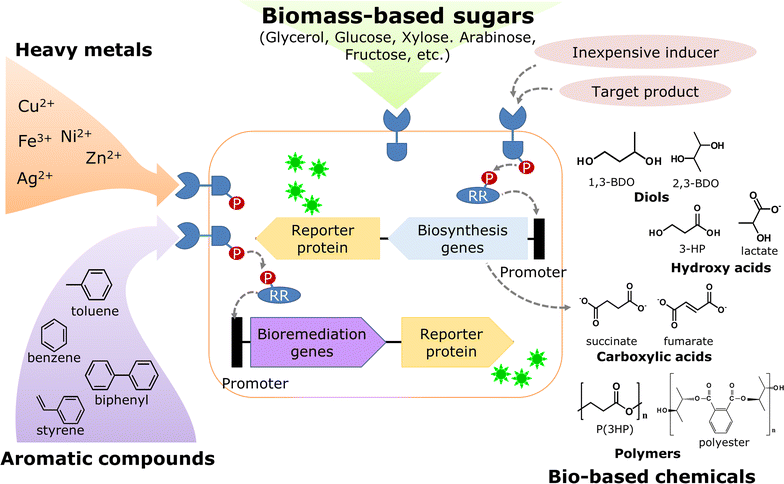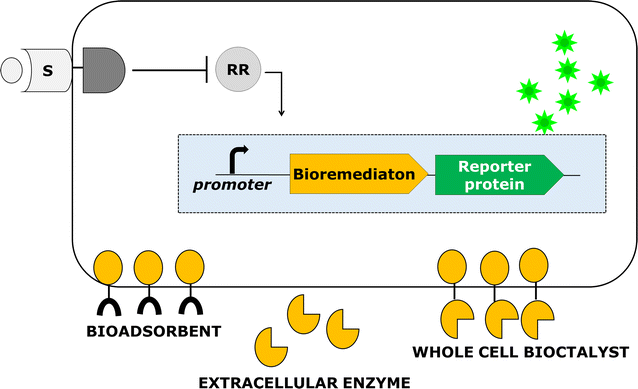Engineered microbial biosensors based on bacterial two-component systems as synthetic biotechnology platforms in bioremediation and biorefinery
- PMID: 28410609
- PMCID: PMC5391612
- DOI: 10.1186/s12934-017-0675-z
Engineered microbial biosensors based on bacterial two-component systems as synthetic biotechnology platforms in bioremediation and biorefinery
Abstract
Two-component regulatory systems (TCRSs) mediate cellular response by coupling sensing and regulatory mechanisms. TCRSs are comprised of a histidine kinase (HK), which serves as a sensor, and a response regulator, which regulates expression of the effector gene after being phosphorylated by HK. Using these attributes, bacterial TCRSs can be engineered to design microbial systems for different applications. This review focuses on the current advances in TCRS-based biosensors and on the design of microbial systems for bioremediation and their potential application in biorefinery.
Keywords: Biorefinery; Bioremediation; Biosensor; Genetic circuit; Two-component regulatory system.
Figures




Similar articles
-
Engineering two-component systems for advanced biosensing: From architecture to applications in biotechnology.Biotechnol Adv. 2024 Oct;75:108404. doi: 10.1016/j.biotechadv.2024.108404. Epub 2024 Jul 11. Biotechnol Adv. 2024. PMID: 39002783 Review.
-
Molecular Mechanisms of Two-Component Signal Transduction.J Mol Biol. 2016 Sep 25;428(19):3752-75. doi: 10.1016/j.jmb.2016.08.003. Epub 2016 Aug 9. J Mol Biol. 2016. PMID: 27519796 Free PMC article. Review.
-
Transcription factor-based biosensors in biotechnology: current state and future prospects.Appl Microbiol Biotechnol. 2016 Jan;100(1):79-90. doi: 10.1007/s00253-015-7090-3. Epub 2015 Oct 31. Appl Microbiol Biotechnol. 2016. PMID: 26521244 Free PMC article. Review.
-
Manipulation of Bacterial Signaling Using Engineered Histidine Kinases.Methods Mol Biol. 2020;2077:141-163. doi: 10.1007/978-1-4939-9884-5_10. Methods Mol Biol. 2020. PMID: 31707657
-
Phosphatase activity tunes two-component system sensor detection threshold.Nat Commun. 2018 Apr 12;9(1):1433. doi: 10.1038/s41467-018-03929-y. Nat Commun. 2018. PMID: 29650958 Free PMC article.
Cited by
-
In vivo biosensors: mechanisms, development, and applications.J Ind Microbiol Biotechnol. 2018 Jul;45(7):491-516. doi: 10.1007/s10295-018-2004-x. Epub 2018 Jan 29. J Ind Microbiol Biotechnol. 2018. PMID: 29380152
-
Bacterial transmembrane signalling systems and their engineering for biosensing.Open Biol. 2018 Apr;8(4):180023. doi: 10.1098/rsob.180023. Open Biol. 2018. PMID: 29695618 Free PMC article. Review.
-
Emerging Opportunities for Synthetic Biology in Agriculture.Genes (Basel). 2018 Jul 6;9(7):341. doi: 10.3390/genes9070341. Genes (Basel). 2018. PMID: 29986428 Free PMC article. Review.
-
Applications and Tuning Strategies for Transcription Factor-Based Metabolite Biosensors.Biosensors (Basel). 2023 Mar 28;13(4):428. doi: 10.3390/bios13040428. Biosensors (Basel). 2023. PMID: 37185503 Free PMC article. Review.
-
Whole-Cell Biosensor for Iron Monitoring as a Potential Tool for Safeguarding Biodiversity in Polar Marine Environments.Mar Drugs. 2024 Jun 28;22(7):299. doi: 10.3390/md22070299. Mar Drugs. 2024. PMID: 39057408 Free PMC article. Review.
References
-
- Liu X, Germaine KJ, Ryan D, Dowling DN. Development of a GFP-based biosensor for detecting the bioavailability and biodegradation of polychlorinated biphenyls (PCBs) J Environ Eng Landsc. 2007;15:261–268.
-
- Harvey BR, Georgiou G, Hayhurst A, Jeong KJ, Iverson BL, Rogers GK. Anchored periplasmic expression, a versatile technology for the isolation of high-affinity antibodies from Escherichia coli-expressed libraries. Proc Natl Acad Sci U S A. 2004;101:9193–9198. doi: 10.1073/pnas.0400187101. - DOI - PMC - PubMed
Publication types
MeSH terms
Substances
LinkOut - more resources
Full Text Sources
Other Literature Sources

